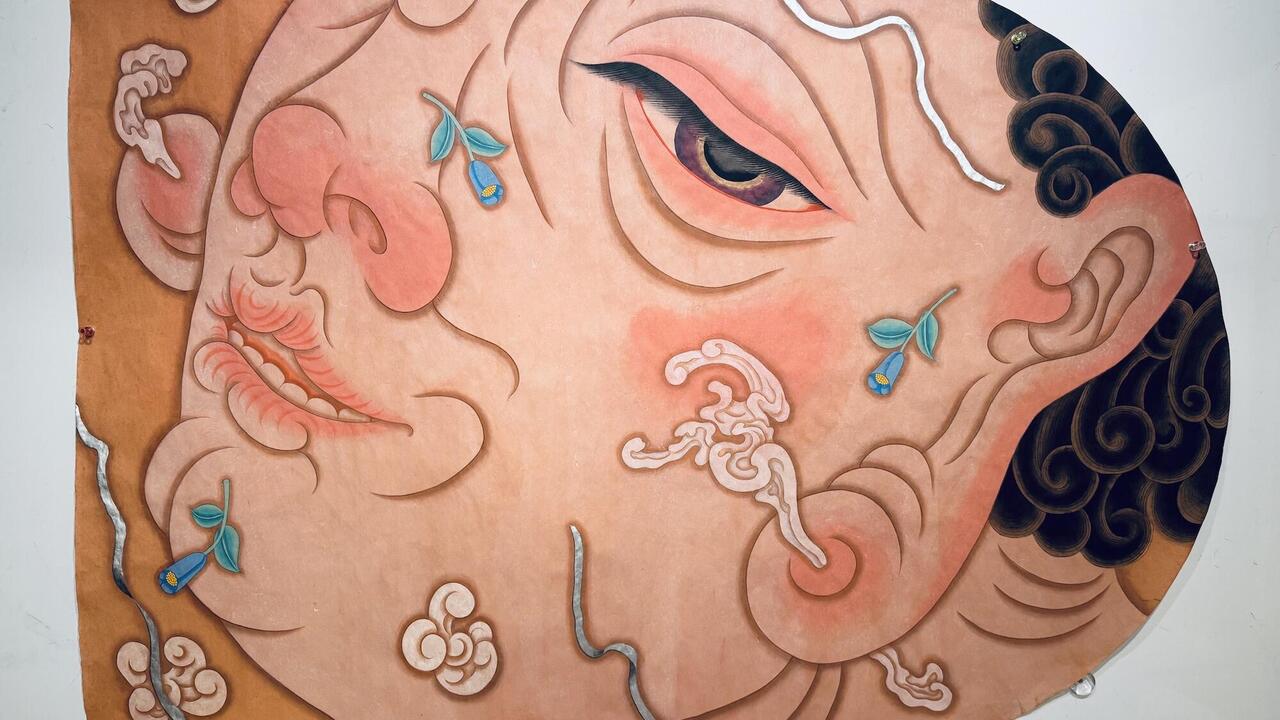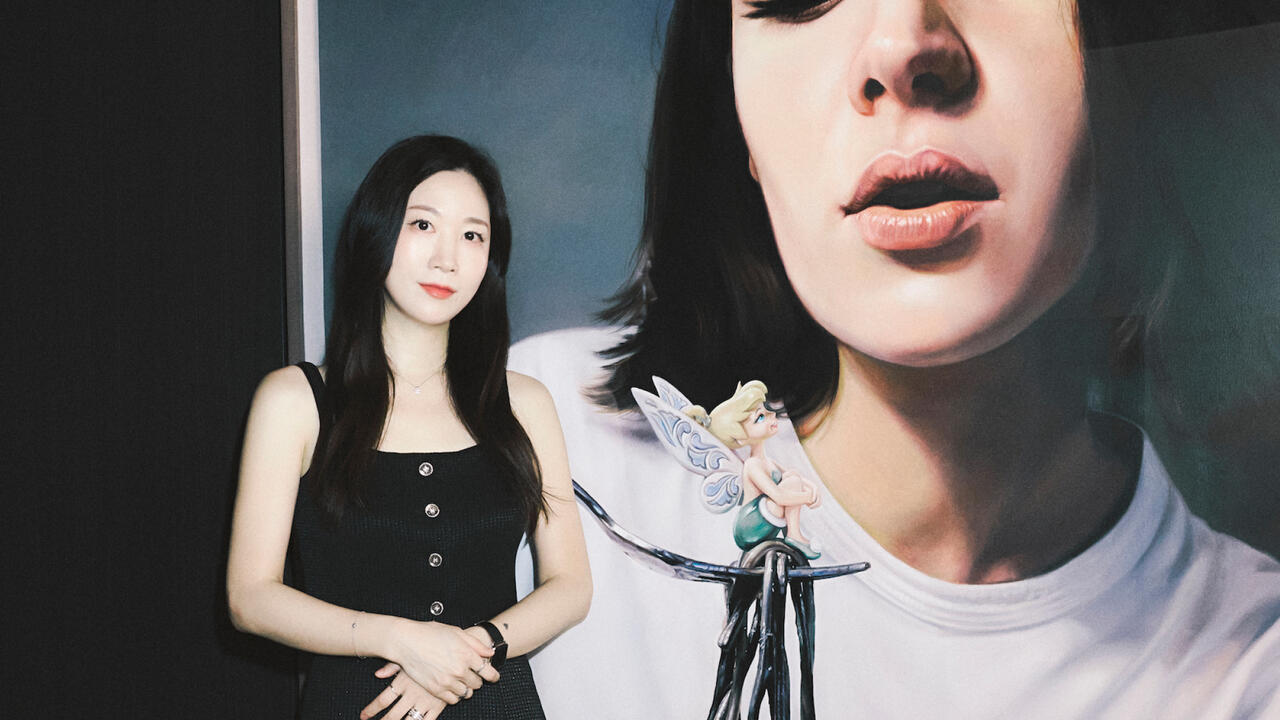Pinch My Arm
Matt Mullican talks about his 40-year career in relation to his recent project, The Meaning of Things
Matt Mullican talks about his 40-year career in relation to his recent project, The Meaning of Things

Jörg Heiser Your work The Meaning of Things (2015) consists of more than 600 collages on A4 paper, each of which includes one image sourced from the internet along with calligraphic elements. Many of these pictures – and not only the ones directly dealing with violence or sexuality – were seemingly chosen because of their viscerality. Looking at your early work from 1973–74, it seems this question of the visceral image has always been important to you?
Matt Mullican At the time, I was in John Baldessari’s ‘post-studio art’ class at CalArts. All my work up to that point had been about light patterns and experiments with projections and so on. But over Easter 1973, I was driving back to CalArts after a day trip and, as I was looking out of the window, an image of a car’s tyre came to me from nowhere. The car that the tyre belonged to didn’t exist; it was fictional. My idea, essentially, was that there is another world that just consists of details, which later I called the imaginary universe, or the fictional reality.
Within weeks, I came up with a drawing of a stick figure I called ‘Glen’ (Untitled, 1973). I made an imaginary studio where he worked. I made about 500 images of him, and I went through psychology, anatomy and biology books in order to come up with descriptions that could be notated underneath: Glen’s circulatory system; Glen forgetting an idea or trying to impress a friend; Glen pinching his arm.

JH What leads from ‘Glen’ to Pinching the Dead Man’s Arm (1973–74)?
MM I was interested in finding life in a dead figure, a dead image. With the ‘Glen’ project, the key picture was that of him pinching himself. With Pinching the Dead Man’s Arm (1973–74), I was trying to identify the pain that the stick figure felt as I understood it in my own psyche. Glen dealt with his own physicality and that of the space: he masturbated or had fits or ate too much or remembered the time he hurt himself skiing.
The conceptual artists had it all perfectly tied up with a big red bow: the object no longer had to be physical, it could just be a statement. So, what could come after that?
JH Two decades before the advent of the internet, you came up with a project involving an avatar, pictograms, ordering systems …
MM I wanted to give Glen a persona: that really came out of the cartoon culture that I grew up with. Later, in 1978, I visited my brother at Stanford who was already on the internet, but I didn’t connect that to art. At CalArts, Lawrence Weiner was very prominent in our lives and, in a sense, we were all looking for the next thing. The conceptual artists had it all perfectly tied up with a big red bow: the object no longer had to be physical, it could just be a statement. So, what could come after that? That’s what started me thinking about the possibility of going into the picture as if it were a real place.
JH Your description again brings up immersive digital environments, and The Meaning of Things is entirely based on online images.

MM I used to go to the picture library in New York; now, the internet is the greatest picture library in the universe. I showed The Meaning of Things to Christopher Williams’s students from the Düsseldorf Academy when they visited my studio in New York, and the first thing they said was: ‘Google knows who you are – the images you get are specifically chosen for you.’ But if Google knows I like a certain kind of porn or if I’m gay or straight or like animals, it’s not a big deal – in some ways, the more tailored the selection is, the more interesting it is to me. But for Williams’s students, that was the crucial point: the question of who has power over the choice of these images.
JH How did the work first come about?
MM I was interested in pictures that affect me physically. I asked myself: ‘What is the most horrible image I can come up with?’ I Googled ‘needle in eye’ and got a whole bunch of pictures, and said: ‘Oh, this is terrible, terrible, terrible!’ In 1974, I made a video called Bleeding Green Blood: it shows me putting a needle in my finger but, as the video is black and white, the blood could be green. It was shown at the Museum of Modern Art in a theatrical setting; Lynne Tillman was in the audience and she got up and left. Afterwards, she came up to me and said: ‘You know, I didn’t want you to feel bad when I left but I had to because I was getting sick from looking at you poking your finger with that needle.’
Pictures can make you sick. That’s one of the key points to The Meaning of Things. It’s why the executions are included; they were the most horrible images I came across.
JH Another category that is important for The Meaning of Things is the point of view, the question of camera perspective.
MM Yes, first person, second person or third person. If I say to you: ‘You are walking down the street,’ you see yourself walking. This is what the arts do – theatre, photography, film – they take you out of yourself. That’s the terrible thing with such horrific images of executions: you’re suddenly stuck in a situation where you can imagine yourself as the perpetrator and as the victim as well but you’re neither. The way we assume other people’s perspectives makes me think ofmirror neurons, which mean that when we see someone on stage, in a sense we are feeling what they do. That’s the visceral response.

I use images from Robert Montgomery’s 1947 film noir Lady in the Lake in The Meaning of Things, as it’s shot from a first-person point of view. The film is hard to watch: it’s boring because, as much as you’re supposed to identify with that first-person camera perspective, you can never ‘become’ the camera as much as you can become a character depicted. We identify with characters to such a great extent that it’s how we understand things.
JH There are also a lot of images that are not sexual or violent but rather obscure, zany or idiosyncratic.
MM I have lots of images of crying men. What is it about them? I have no idea. They affect me. This whole project is from a man’s point of view. There are very few first-person depictions of sex from the woman’s perspective – I only found three online and I was really looking for them. Another subject is people looking at mirrors. It wasn’t something that I was involved in initially, but then ghosts came into that category and it became ‘ghosts and mirrors’.
JH What leads from one picture or subject to the next?
MM I can’t say I understand the whole thing, other than that it’s intuitive. I asked my assistant, the artist Albrecht Pischel, how he thought I should order everything and he said: ‘Why don’t you just put the images in the order in which you uncovered them?’ And so I did that. Instead of adding the actual search term to the image on the A4 page, I draw calligraphic ink lines around each of them as an expression of the words’ physicality. But what exactly is that pattern supposed to mean? I have no clue. This is something that has allowed me to grow older as an artist – I have a lot of reverence for what I don’t know, even if I make it myself.

JH Can you explain why there are also a lot of images of the banal and everyday – getting up, having breakfast, going to work etc.?
MM Yes, towards the end of the project it became all about the daily grind. Breakfast, lunch and dinner, going to work – they’re very important. In a funny sense, this all comes out of me marking out the days in my work as an artist. A lot of it also comes out of hypnosis, which I’ve often included as part of my work or performances.
My favourite sentence in Claes Oldenburg’s ‘I Am for an Art …’ statement of 1961 is: ‘I am for an art that grows up not knowing it is art at all, an art given the chance of having a starting point of zero.’
JH Would you agree that what your hypnosis work and The Meaning of Things have in common is the idea of losing or giving away control – tricking the superego?
MM I think it’s a condition of normalcy to be in a trance but with hypnosis it’s more obvious. Selecting these images, I’m responding to my visceral response, which I don’t control. And, under hypnosis, I subject myself to a state in which another element or layer of my body takes over. I like getting away from the authority of the artist. We’ve become so literal in our understanding of how art functions that it rubs me up the wrong way. Thanks to the internet we’re always choosing between things: where to get the best meal, the best clothes or the cheapest flight. Our brains are caught up in this constant multiple-choice reality to such an extent that, as artists, as creative beings, we should say: ‘Let’s jump off this platform!’
JH In a text published in 1979, Allan MacCollum described your work as being about ‘bringing realms of knowledge into conflict’. Could it be said that, in a sense, you’re addicted to the cognitive dissonances produced by that conflict?

MM Yes, that’s the way that I function. For some reason, that’s the chemical in my head, which allows me to do what I do. Rosemarie Trockel, whom I’ve known for a long time, once asked me where I lived and I said: ‘I live over the Atlantic.’ I have a studio in Berlin and one in New York, so I’m continuously going back and forth. She said: ‘I’ve always thought of you like that: you’re in-between.’ On the one hand, I’m doing banners of pictograms and, on the other, I do the cosmology or the hypnosis work, where the references are not clear. It’s the way that I function – it’s like putting two atoms together trying to come up with a new element.
My favourite sentence in Claes Oldenburg’s ‘I Am for an Art …’ statement of 1961 is: ‘I am for an art that grows up not knowing it is art at all, an art given the chance of having a starting point of zero.’ I’m constantly trying to get to zero and it’s one of the methods that lead me to The Meaning of Things.
JH Apart from drawing calligraphic lines, you also made symbolic signs – for example, a button with arrows going in all four directions. What do these lines and symbols indicate?
MM With the symbols, I tried to come up with a system indicating the viscerality of an image. So I drew that button with arrows – like an electric shock. But it should actually be chemical energy.
Matt Mullican is an artist who lives in New York, USA, and Berlin, Germany. The Meaning of Things was shown in 2015 at ProjecteSD, Barcelona, Spain. In March, his book The Meaning of Things: Who Feels The Most Pain was published by Black Dog. His solo exhibition, ‘Between’, is at Capitain Petzel, Berlin, until 16 April; ‘Nothing Should Exist’ will be at Kunstmuseum Winterthur, Switzerland, from 11 June to 16 October.























